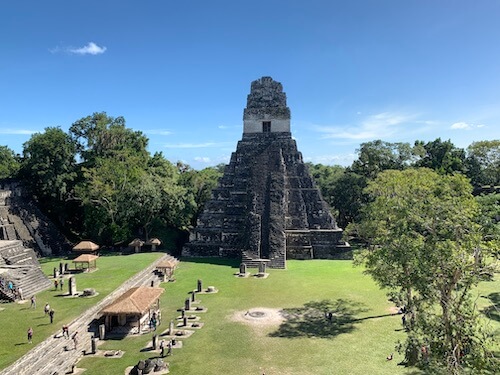 “Imagine this whole area without the trees and a white stucco floor beneath your feet,” our guide says as he waves his arms towards the jungle.
“Imagine this whole area without the trees and a white stucco floor beneath your feet,” our guide says as he waves his arms towards the jungle.
Picture thousands of people crammed into this plaza one early morning, looking up expectantly at the huge stone pyramid in front of us. As the sun begins to rise their god-king dramatically appears from an alcove at its pinnacle. He’s a fearsome figure dressed in jaguar skins and cascading quetzal feathers, and his people bow in awe as he addresses them.
I’m in awe myself as I explore the temples of Tikal, an ancient Maya settlement in northern Guatemala in central America. Some of the giant stone blocks that form the pyramids and temples still bear traces of a vivid red dye that originally covered them.
A wooden staircase helps visitors to summit Temple IV, a 65m pyramid that soars high above the treetops, and we look out over a rainforest that stretches away to a lake in the distance.
 Tikal dates back to 600BC, but enjoyed its golden era from 250AD to 900AD, when most of its finest buildings were designed. It’s deep in the rainforest and lay abandoned for centuries, but over the last few years many of its temples, palaces and astronomical observatories have been uncovered. Laser technology has shown the archaeologists that up to 3,000 other structures still lie buried under the trees and grass.
Tikal dates back to 600BC, but enjoyed its golden era from 250AD to 900AD, when most of its finest buildings were designed. It’s deep in the rainforest and lay abandoned for centuries, but over the last few years many of its temples, palaces and astronomical observatories have been uncovered. Laser technology has shown the archaeologists that up to 3,000 other structures still lie buried under the trees and grass.
One of the wonderful things about Tikal is that few tourists make it to Guatemala, so it’s far less crowded than the more famous Inca site of Machu Picchu. It’s also several centuries older, yet the ancients Mayas were an advanced civilization with sophisticated methods of writing, carving, astronomy and maths. Their accurate calendars and detailed workmanship have allowed archaeologists to decipher carvings that show exactly when great events like battles occurred or new kings ascended.
At the less famous site of Aguateca you’ll probably be the only person wandering around ruins that sit on top of a 90m high precipice, chosen – ineffectively – to keep enemies at bay. When the city was ransacked by a rival army people fled so quickly that they left everything behind, giving archaeologists a great insight into their daily lives.
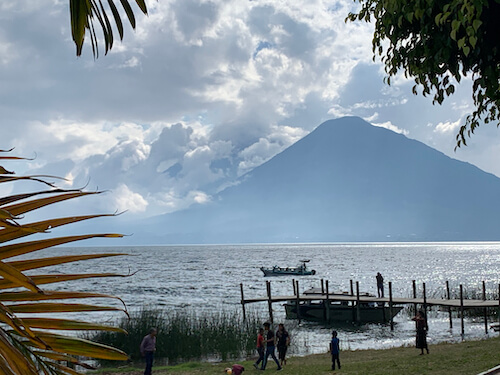 I explored Guatemala with Wild Frontiers and its tour guide Alejandro Gillot, an archaeologist who’s as interesting himself as his stories. When he talks about tunnelling inside the pyramids to examine their construction, you know he was one of those doing the burrowing. Gillot is also the ex-drummer of one of Guatemala’s top rock bands, Viernes Verde (Green Friday), and I noticed some younger locals taking a second glance to see if it really was him.
I explored Guatemala with Wild Frontiers and its tour guide Alejandro Gillot, an archaeologist who’s as interesting himself as his stories. When he talks about tunnelling inside the pyramids to examine their construction, you know he was one of those doing the burrowing. Gillot is also the ex-drummer of one of Guatemala’s top rock bands, Viernes Verde (Green Friday), and I noticed some younger locals taking a second glance to see if it really was him.
The Maya empire is believed to have collapsed from a fatal mix of drought, famine and over-population, and Guatemala still has problems today. Poverty is rife, and the country was devastated by a 36-year right-wing dictatorship. The government’s intelligence and military forces committed genocide against descendants of the Maya and opponents of the state until peace was negotiated in 1996. Entire villages were massacred in rural areas that were rebel strongholds, and several churches in these village have shrines to commemorate the victims. Long, twisting roads lead up into these areas in the Cuchumatanes mountains, and it feels different from the rest of the country, with cold, misty weather that seems to match the current poverty and the sombre past.
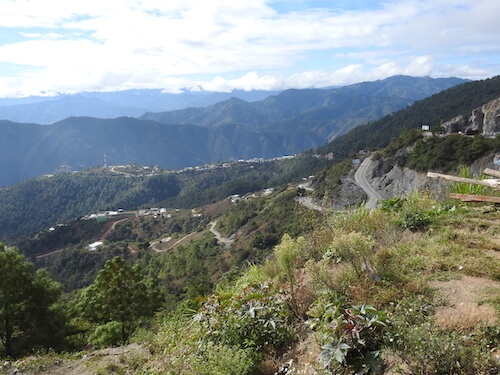 While this recent history is essential for anyone who wants to understand the country, it’s the ancient Maya history that beguiles most visitors. The scenery is another big attraction, with spectacular mountains, volcanoes surrounding picturesque lakes, and the former capital Antigua considered one of the prettiest towns in Central America.
While this recent history is essential for anyone who wants to understand the country, it’s the ancient Maya history that beguiles most visitors. The scenery is another big attraction, with spectacular mountains, volcanoes surrounding picturesque lakes, and the former capital Antigua considered one of the prettiest towns in Central America.
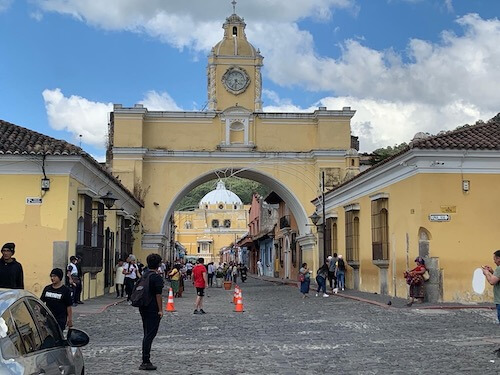 Antigua was founded by Spanish Conquistadors in 1543 and was declared a UNESCO World Heritage Site in 1979. But this is earthquake territory, and its ancient, cobbled streets are dotted with endless churches and convents left in ruins by a series of seismic shakes. The cathedral is little but a gorgeous façade in front of an empty shell, with massive chunks of pillars lying in disarray where they fell in an earthquake of 1773.
Antigua was founded by Spanish Conquistadors in 1543 and was declared a UNESCO World Heritage Site in 1979. But this is earthquake territory, and its ancient, cobbled streets are dotted with endless churches and convents left in ruins by a series of seismic shakes. The cathedral is little but a gorgeous façade in front of an empty shell, with massive chunks of pillars lying in disarray where they fell in an earthquake of 1773.
One stoic survivor of the damage is Iglesia Merced, a gaudy wedding-cake of a building with yellow walls garnished with white filigree. A short stroll away is the Arco de Santa Catalina, an arch built in 1694 that tantalises today’s travellers with promises of the perfect Insta-pic. From one side you can photograph Iglesia Merced through the arch, and from the other you can capture the perfectly conical peak of Agua Volcano in the background. I failed to do justice to either and focused on some wine instead, in an atmospheric wine bar under the arch that serves a wide choice by the glass, with the prices descending as you order more.
The streets around here are crammed with squat houses painted in jaunty pinks and yellows. But the size of some of these ancient buildings is amazing, with deceptively narrow entranceways leading into a maze of rooms and courtyards that can extend across an entire block.
One evening I dined in Sobremesa, a restaurant where the small front room opens up into a pretty courtyard. Upstairs is a rooftop terrace with views over the mountains and the trio of Agua, Fuego and Acatenango volcanos. Food in Guatemala often involves rough corn tortillas, mashed black beans, avocado, chicken stews and pumpkins. But at Sobremesa the owner-chef Alexander Ferrar has let his imagination run free, and come up with treats like jalepeno banana chicken breast with fried bananas and tomato chutney.
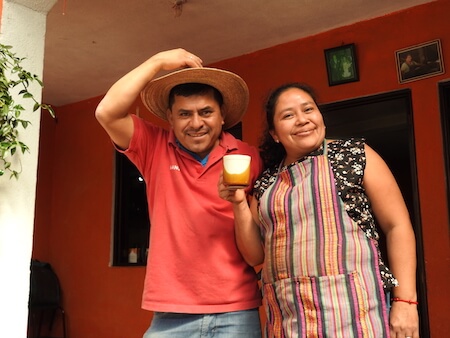 While Guatemala isn’t top of many people’s To Do list, this small country of 17 million people is worth the effort of getting there. While many of its people eke out a living in rural communities, some entrepreneurial initiatives are helping them to reach a wider market. One of the most successful is De La Gente, a cooperative that supports coffee farmers through organised marketing and community tourism. Our group visited the ever-smiling Manuel Gomez, who showed us around his plantation then introduced his wife Rosa Rodriquez, who had us grinding and roasting coffee beans before serving us a home-cooked lunch.
While Guatemala isn’t top of many people’s To Do list, this small country of 17 million people is worth the effort of getting there. While many of its people eke out a living in rural communities, some entrepreneurial initiatives are helping them to reach a wider market. One of the most successful is De La Gente, a cooperative that supports coffee farmers through organised marketing and community tourism. Our group visited the ever-smiling Manuel Gomez, who showed us around his plantation then introduced his wife Rosa Rodriquez, who had us grinding and roasting coffee beans before serving us a home-cooked lunch.
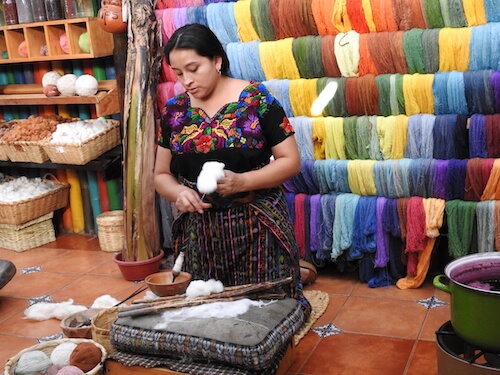 Weaving is another staple industry, with cooperatives helping hundreds of women to work together in centres where they can demonstrate their craft and sell the finished products. The colours are vibrant, and it’s wonderful to see so many women in the streets still wearing the traditional voluminous multi-coloured skirts and embroidered blouses that shimmer with glitzy, golden threads.
Weaving is another staple industry, with cooperatives helping hundreds of women to work together in centres where they can demonstrate their craft and sell the finished products. The colours are vibrant, and it’s wonderful to see so many women in the streets still wearing the traditional voluminous multi-coloured skirts and embroidered blouses that shimmer with glitzy, golden threads.
After two weeks of exploring it’s great to end by relaxing on a beach, and this oddly-shaped country has both Pacific and Atlantic coastlines. Livingston on the east coast boasts an Afro-Caribbean vibe thanks to the historical influx of shipwrecked Nigerian slaves who arrived via the island of Saint Vincent. The intriguing thing is that the town is only reachable by boat, since there are no roads heading inland. The few cars in the town itself all arrive on floating metal platforms that serve as ferries, and their mileage must negligible with nowhere much to go.
We caught a small boat from the town of Rio Dulce and chugged along the river for an hour, passing fat pelicans and watching sunset over the forests. From Livingston it’s another 45-minute boat trip to Playa Blanca, where a small entrance fee covers facilities including clean toilets and changing rooms, well-priced food and drinks, and a sea warm enough for swimming. I lay in a hammock slung between two palm trees and sipped milk from a coconut, delighted to be in a country - and on a beach - so far off the beaten path.
First published in Business Day.